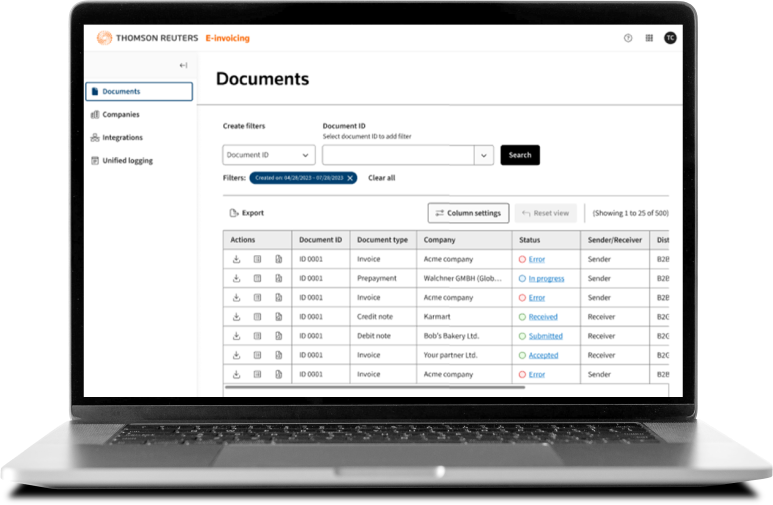In the first two installments of our blog series on e-invoicing and Continuous Transaction Controls (CTCs), we discussed the basics of e-invoicing and how it affects tax teams and compliance efforts. In this article, the third and last of the series, we will explore some of the regional complexities and challenges that companies may encounter with e-invoicing and CTCs, as well as updates on regulatory changes and strategies for keeping up with the requirements that typically accompany these mandates.
The purpose of this series is to help readers gain a better understanding of e-invoicing and CTC, and their impact on corporate tax teams. Our guest expert, Nazar Paradivskyy, VP of Regulatory Affairs at Pagero, will help explain what companies need to know to transition smoothly into this new era of digital invoicing. Pagero helps companies manage all aspects of their e-invoicing compliance responsibilities, and Nazar Paradivskyy heads the company’s global regulatory department.
Challenges of e-invoicing compliance
For multinational companies, e-invoicing compliance is complicated by several factors:
- One of the most problematic issues is the fact that there are no widely accepted international standards for e-invoicing. At the moment, the closest thing to an emerging standard are Peppol (4-corner) and Peppol CTC (5-corner) frameworks, but there are dozens of others. Without a harmonized or at least aligned international standard, every country is free to devise and implement its own version of e-invoicing, with its own specific rules and requirements.
- Consequently, a company that does business in thirty different countries could have thirty different e-invoicing formats and requirements to manage from the regulatory perspective, on top of the business, or industry-specific requirements and technical standards that after time will continue to exist next to the mandatory requirements.
- Companies trying to comply with each country’s regulations could encounter a minefield of complications, including last-minute rule changes, inaccurate or incomplete technical specifications; inconsistencies between the technical specifications and the underlying regulatory framework; software incompatibilities, and a host of other obstacles.
- For example, some e-invoicing mandates are often accompanied by continuous transaction controls (CTCs), which require businesses to submit transaction data (e.g., VAT/GST and sales and use taxes) for approval by tax authorities, in real-time or close to it, before a transaction can take place between the trading partners.
Automated software solution is the only practical way for companies to comply with e-invoicing/CTC mandates, and—depending on the sophistication of the company’s existing systems—implementing such a solution could require anything from a few tweaks of an ERP to a complete system overhaul, especially if it is to account both for legal and business requirements and processes. Also, providing standard pre-built integrations that connect to any government or business network will minimize deployment and maintenance costs.
Part 1: E-invoicing basics for compliance professionals →
Part 2: How e-invoicing and CTCs impact tax teams and compliance efforts →
Getting ahead of regional differences
More than 80 countries have already passed e-invoicing legislation, and dozens more are expected to follow in the next few years. For impacted companies, it is imperative to get ahead of the e-invoicing juggernaut and understand precisely what measures and actions will be necessary to meet the company’s compliance obligations.
“The best thing businesses can do is assume that this is just the beginning, and that e-invoicing/CTC mandates are here to stay,” advises Pagero’s Nazar Paradivskyy. “Being reactive will be costly.”
CTC compliance by region/country
To give you an idea of the variety of e-invoicing mandates being implemented around the world in the next few years, here is what these new digital tax protocols will look like in several regions/countries:
Europe
Europe is probably the most complex region with 40+ jurisdictions, with the majority being part of the European Union (EU), but many are outside the EU. Both regulations, where there is a mix of domestic and EU frameworks, create the complexity, and the fact that contrary to many other regions, Europe is leading regarding business digitalization and automation, thus these two angles must be observed.
Because of certain provisions of the VAT Directive, EU Member States are in fact not allowed to mandate B2B e-invoicing. This can only be achieved by asking for approval (derogation) from the European Commission, which Italy (since 2019), Romania (starting January 2024), Poland (starting July 2024), and France (starting in 2026) have done, or implementing alternative real-time digital control models that are not based on e-invoicing, which happened in Hungary (real-time reporting), Spain (near-real-time reporting) and Greece (reporting of invoice synopsis). New e-invoicing frameworks are expected to be put in place soon in Belgium, Croatia, Germany, Slovenia, and Spain, to name a few. In parallel, you have the Procurement Directive, which has made B2G e-invoicing mandatory for suppliers in most Member States. We should also not forget non-EU jurisdictions, for instance, in Norway, nearly 90% of all invoices are electronic voluntarily. Or Serbia with Turkey, who have implemented country-side CTC e-invoicing schemes.
In the most recent developments, the new ViDA proposal from the EU aims to make intra-community e-invoicing and DRR mandatory for all Member States, as well as harmonize the future CTC mandates to be introduced in the remaining jurisdictions.
Middle East
Many Middle Eastern countries since they have introduced VAT are in the process of either implementing e-invoicing or laying the legislative groundwork for it. Israel will introduce e-invoicing along with a real-time reporting CTC model in January 2024 with invoices exceeding 25,000 NIS. According to Israeli Tax Authorities, implementation will start in April 2024. Saudi Arabia, for instance, is currently rolling out the “integration” phase of its e-invoicing program, starting with the largest companies and, throughout the year, moving to mid-size, and smaller companies. Notably, B2B and B2C transactions follow different CTC models, where B2B is subject to pre-clearance, while B2C follows the real-time reporting approach. Meanwhile, the United Arab Emirates is waiting until July 2025 to start the “mandatory” part of its CTC e-invoicing program for B2B transactions. Other Gulf Cooperation Council countries (Bahrain, Kuwait, Oman, Qatar) are also planning to roll out e-invoicing systems with CTC.
Asia-Pacific
CTC implementations are diverse, with a range of countries implementing Peppol (either 4-corner or 5-corner model), such as Australia, New Zealand, Singapore, and Japan. At the moment, this implementation has a voluntary character, but could at any point elevate into a country-wide mode, such as the developments set in Singapore, which are in the process of upgrading to Peppol CTC. Others, such as India, the Philippines, or Vietnam have opted into the pre-clearance model. Most notably, there are active ongoing discussions among countries in the region to put a joint Peppol-based framework for cross-border trade in the region. Even South Korea, which had the CTC rolled out back in 2011, is considering this option. China is in the final phase of the build-up of its new e-fapiao framework, and a CTC introduction is expected to start in 2025. However, before that, China is working on resolving some of the data export/processing challenges it has created when implementing the current PIPL and cyber security frameworks, which make processing of invoice data outside of China largely impossible.
Latin America
Latin America was the first region to regulate the use of e-invoicing. Chile began its famed program in 2003, Mexico in 2004, and Brazil in 2006. Unfortunately, being early movers, they have turned an invoice, which is a commercial document, into a fiscal report. Thus, many jurisdictions currently introducing CTC e-invoicing frameworks study these implementations to avoid making the same mistakes, and among others, not turning e-invoicing into invoice reporting. More than 15 Latin American countries have implemented e-invoice/CTC systems, the latest being El Salvador and the Dominican Republic.
Preparing for the future of e-invoicing
This is just the tip of the e-invoicing iceberg, however. To prepare for the inevitable expansion of e-invoicing, Pagero’s Nazar Paradivskyy, advises companies to review their existing systems and processes to determine what changes will be necessary given the countries in which they do business or where they intend to expand. Then, “businesses should start looking for reliable partners and solutions to support them in this transformation journey,” says Nazar—because going it alone can be difficult, time-consuming, and costly.
To address the challenges presented by e-invoice mandates, Thomson Reuters has released ONESOURCE e-invoicing, a centralized platform that streamlines and automates e-invoicing compliance by combining Thomson Reuters global tax content with Pagero’s industry-leading e-invoicing expertise. This industry-leading partnership has produced an easy-to-use solution that connects with most enterprise resource planning (ERP) systems and offers the most cost-effective way for multinational companies to comply with e-invoicing mandates in more than 80 countries around the world.
 |
|







